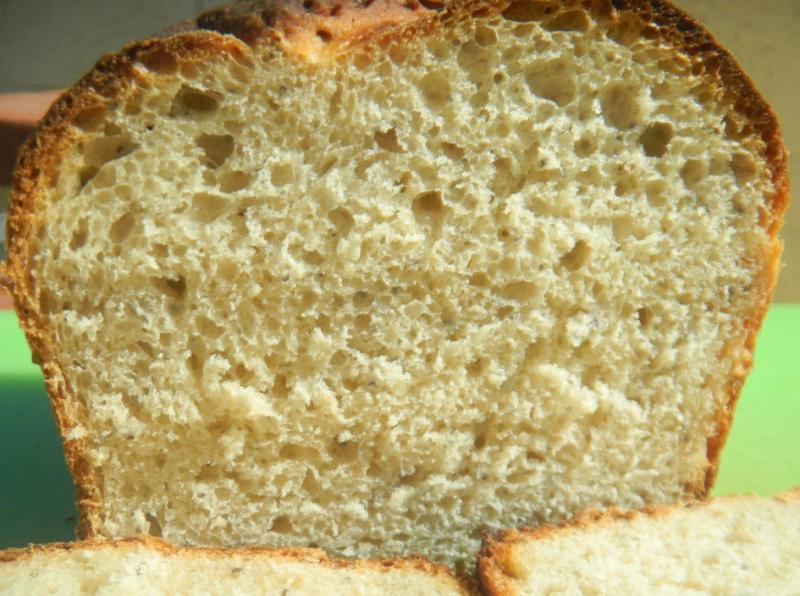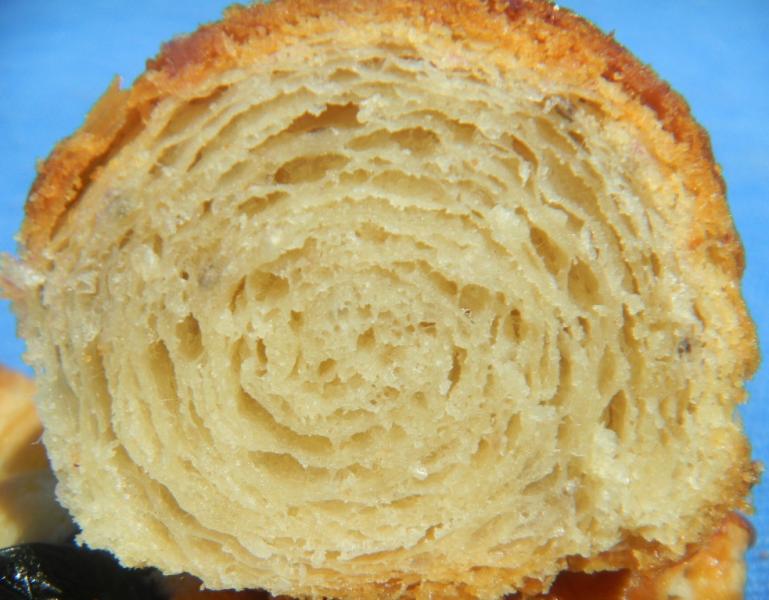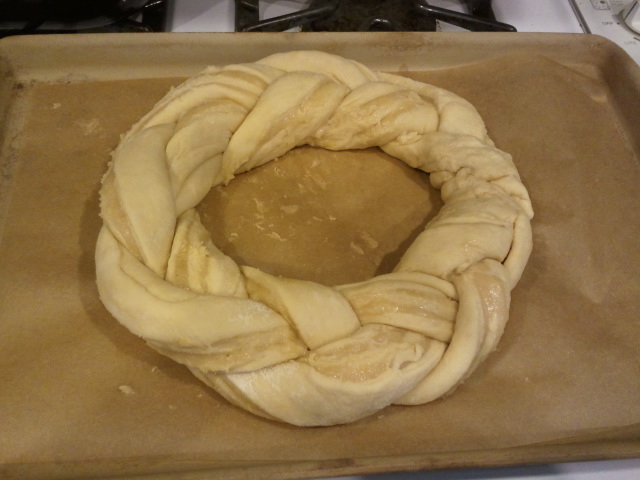We were inspired, even though the wrong time of year for laminated doughs with it being 8o F inside and 105 F outside in AZ, by txfarmer's croissants and Danish pastries.


Hers are just fantastic to look at and professional in every way - unlike mine. But, I thought we would give it a go now and get back to them later next winter. Her posts can be seen here: http://www.thefreshloaf.com/node/22677/poolish-croissant-pursuit-perfection and here http://www.thefreshloaf.com/node/26777/cheese-danish-sourdough-all-american-beauty


We needed to change her recipe from yeast to sourdough and yeast water since I no longer stock any commercial yeast. I didn't expect my first attempt at laminated dough to be anywhere near txfarmer's and I was right. Freezing some of the croissants and Danish didn't help any either I suppose :-) But I did learn many important things about lamination which will help my assistant out later.



A very nice grilled; Amish Swiss and pepperjack cheese with grilled chicken sandwich made for lunch with this fine white sandwich bread. Love the chia seeds. The sweet potato and the pickled tomato, red onion and cucumber salad were also nice.

We made this enriched dough (can't believe it didn't have cream in it too) into 3 variations with various flavors; a non -laminated white sandwich bread (half of the dough split off before lamination), 3 kinds of Danish (blueberry, strawberry and dried apricot) and 2 kinds of croissants (plain and with a sweet home made mince meat filling made with beef shanks - those are the fat ones that didn't have 7 steps).


Used 27.5% of the total dough weight in roll-in butter (180 grams), txfarmer recommends 30% but we had a few more add ins than her recipe that upped the total weight. Txfarmer also said to hold the hydration down al little and I managed to somehow up it slightly,at least a couple of percent, if I calculated properly. We used dried apricots and they burned on the top and I should have reconstituted them in bourbon or water. We wanted to take them out of the oven at 25 minutes but by mistake took them out at 22 minutes and they could have used another 3 minutes in the oven. If you live in AZ it is best to do this in the wintertime.


My wife summed it up best. They don't look too good but they taste OK. I give the sandwich loaf a solid B and the rest a C only because it was a first attempt - my apprentice is worried she will soon be replaced since she said she was a lamination freak - well, at least the freak part was right:-)

The formula and method follows the pictures.

Method
Build the levain over 3 - 4 hour steps. I mixed the YW and the SD together from the beginning as is our usual now a days. Mine had more than doubled over 12 hours and then I refrigerated it overnight.
The nest morning, mix everything except the levain and the salt together in the mixing bowl and autolyse for 1 hour. Add the levain and the salt and mix on KA 2 for 4 minutes and KA 3 for 1 minute. Remove to an oiled bowl and rest for 15 minutes. Do (4) S &F’s every 15 minutes. At the 1 hour mark let the dough develop and ferment for 1 hour.
At this point I split off half the dough and formed it into a boule and let it ferment for another hour. Then it was formed into a loaf, placed into a Pyrex loaf pan and refrigerated for 4 hours. It doubled in the fridge. It was then removed and allowed to final proof for 3 hours. When it tripled in volume from when it initially went into the loaf pan, we slashed it and put it into a425 Fmini oven with steam for 10 minutes. The steam was removed and the temperature turned down to 375 F convection this time. The loaf was turned 180 degrees every 4 minutes 2 times. At this point the loaf was removed from the Pyrex and allowed to finish baking turning 2 more times at 5 minute each. When the loaf reached 205 F the loaf was allowed to stay in the off oven with the door ajar for 10 more minutes to crisp the crust.. It was then removed to a cooling rack.
The other half of the dough was used for lamination and I followed txfarmer’s method and procedure. I used180 gramsof roll-in butter for 645 g of dough (27.5%). The croissants and Danish were retarded overnight in a plastic bag in the fridge where the back half of them froze – no harm done though. In the morning, they came out of the fridge for final proof – this took about 2 ½ hours. Then they were placed in the 425 F oven for 22 minutes (should have been 25 minutes) rotated half way through and the temperature turned down to 375 F convection. When done they went onto a cooking rack from the parchment covered baking sheet.
Formula
| YW and SD Laminated Croissant Dough | | | | | |
| | | | | | |
| Mixed Starter | Build 1 | Build 2 | Build 3 | Total | % |
| SD Starter | 25 | 0 | 0 | 25 | 3.80% |
| Yeast Water | 30 | 20 | 20 | 70 | 16.28% |
| AP | 55 | 50 | 110 | 215 | 31.40% |
| Water | 25 | 30 | 50 | 105 | 24.42% |
| Total Starter | 135 | 100 | 180 | 415 | 96.51% |
| | | | | | |
| Starter | | | | | |
| Hydration | 82.42% | | | | |
| Levain % of Total | 32.40% | | | | |
| | | | | | |
| Dough Flour | | % | | | |
| AP | 425 | 98.84% | | | |
| Dough Flour | 430 | 100.00% | | | |
| Salt | 9 | 2.09% | | | |
| Milk | 206 | 47.91% | | | |
| Dough Hydration | 47.91% | 0.00% | | | |
| | | | | | |
| | | | | | |
| Total Flour | 657.5 | | | | |
| Total Water/Milk | 393.5 | | | | |
| T. Dough Hydrat. | 59.85% | | | | |
| | | | | | |
| Hydration w/ Adds | 71.76% | | | | |
| Total Weight | 1,281 | | | | |
| | | | | | |
| Add - Ins | | % | | | |
| VW Gluten | 5 | 1.16% | | | |
| Sugar | 40 | 9.30% | | | |
| Butter | 50 | 11.63% | | | |
| Egg | 90 | 20.93% | | | |
| White Rye Malt | 5 | 1.16% | | | |
| Barley Malt | 16 | 3.72% | | | |
| Chia Seeds | 15 | 3.49% | | | |
| Total | 221 | 51.40% | | | |

 Helen made hers with Almond filling and made a beautiful braid, garnished with cherries and slivered almonds.
Helen made hers with Almond filling and made a beautiful braid, garnished with cherries and slivered almonds. 



